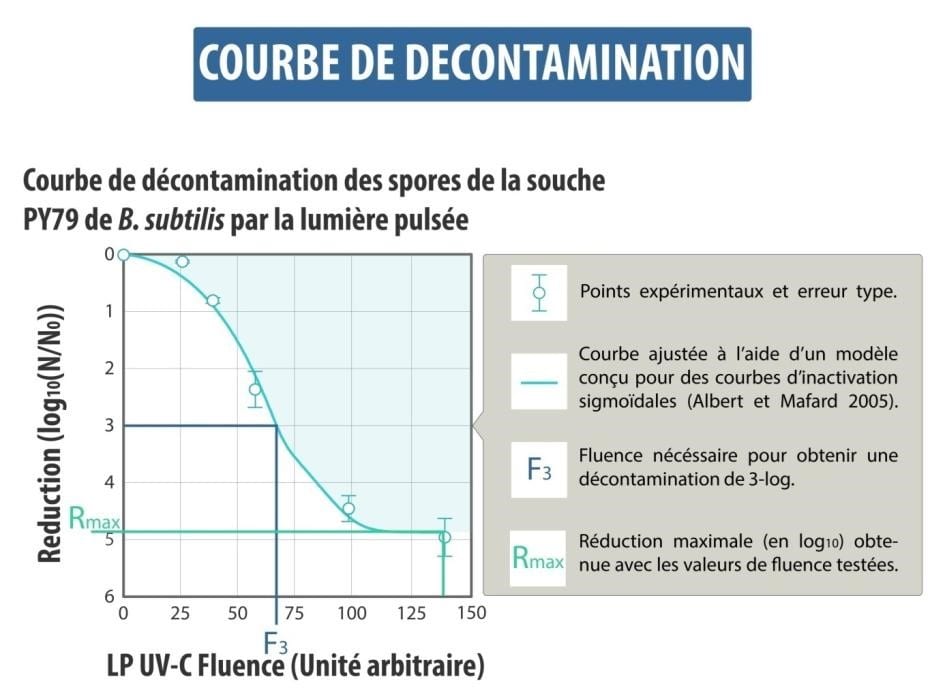Principle and Effect on microorganisms
History of pulsed light sterilization
The initial tests with intense light flashes for microbiological decontamination date back to the 1970s in Japan.
The first patent for pulsed light technology was granted in 1984 (Hiramoto). It described the use of xenon lamps for microbiological decontamination.
Between 1990 and 2000, research laboratories carried out tests on a wide range of products, foodstuffs, and medical devices to assess the effectiveness of flashes of pulsed light for decontaminating surfaces.
Although these studies, carried out by microbiologists, demonstrated effective decontamination, they never established a correlation between the physical parameters of the process (power of the pulse, energy) and its effectiveness for the destruction of microorganisms. This “dose-response” relationship is essential for the scale-up and the design of industrial equipment. As a result, the technology remained at the laboratory stage until the early years of this century.
It was then that the first tests on the decontamination of packaging were carried out, and also that Claranor was established, in 2004.
Claranor Pulsed Light technology
The Claranor Pulsed Light technology is based on the anti-microbial effect of pulses of white light.
The Claranor pulse is produced in 2 steps:
– A 20 kV pulse lasting a few nanoseconds makes the xenon-filled lamp conductive while creating an electric arc in the lamp
– The capacitor charged at 3000 V discharges in this arc during a 300-microsecond pulse, which ionizes the gas in the lamp and generates a plasma emitting a very high-intensity white light (20,000 times greater than sunlight on the earth’s surface)
The pulse covers the full white light spectrum and has a particularly high UV output (UV light is well-known for its anti-microbial properties).
The energy of the lamp, which is delivered over a very short period (0.3 ms), produces a power of 1 MW, half of which is dissipated in heat and the other half in optical energy. The UV light represents 20% of this optical energy, i.e. 100 kW during the pulse (approximate values).


Source: M. Clair and M. Carlin, INRA PACA
TOTAL DESTRUCTION OF MICROORGANISMS
Applying one or more flashes of pulsed light to microorganisms causes their immediate, total, and irreversible destruction.
This destruction is based on two principles:
– Denaturation of the macromolecules of the living organism (DNA, structural and metabolic proteins, enzymes) by the UV light;
– Accentuation of this denaturation by the powerful effect of this white light.
The effectiveness of the technology has been demonstrated on flat surfaces (plastic) on a wide range of microorganisms: bacteria in both vegetative and sporulated form (including thermo resistant spores), molds, yeasts, and viruses.
The level of decontamination obtained depends on the intensity of the treatment, and the quality and geometry of the surface to be treated.
MECHANISMS OF ACTION OF THE PULSED LIGHT TECHNOLOGY
The mechanisms of action of the technology have been studied extensively in the context of collaborations between Claranor and its scientific partners,
in particular INRAE (French National Institute for Agricultural Research) and CNRS (French National Center for Scientific Research).


A PhD (2008 – 2010), carried out within the framework of a collaboration between Claranor and INRA, has played a key role in defining the “dose-response” relationship, which is fundamental to the design of Claranor’s equipment.
A QUESTION, A PROJECT, LET’S DISCUSS WITH OUR PULSED LIGHT EXPERTS

Christophe

Anna

Benjamin

Anthony
Scientific publications:
Claranor-INRA thesis, Caroline Levy : “Main factors influencing the effectiveness of Pulsed Light for the decontamination of pathogenic and spoilage micro-organisms in food products”
Role of pigmentation in protecting Aspergillus niger conidiospores against pulsed light radiation
Esbelin J, Mallea S, J Ram AF, Carlin F (2013). Photochem Photobiol. 2013 May-Jun;89(3):758-61. doi: 10.1111/php.12037. Epub 2013 Jan 29.
The photoprotective potential of fungus pigments was investigated by irradiating conidiospores of three Aspergillus niger strains possessing the same genetic background, but differing in their degree of pigmentation with pulsed light (PL) and monochromatic (254 nm) UV-C radiation. Spores of A. niger MA93.1 and JHP1.1 presenting, respectively, a fawn and a white pigmentation were more sensitive to PL and continuous UV-C radiation than the wild-type A. niger strain N402 possessing a dark pigment. Both spores of the dark A. niger N402 and the fawn-color mutant were equally resistant to moist heat at 56°C while spores of the white-color mutant were highly sensitive. These results indicate that melanin protects pigmented spores of A. niger from PL.
Decontamination of sugar syrup by pulsed light
Chaine A, Levy C, Lacour B, Riedel C, Carlin F (2012). J Food Prot. 2012 May;75(5):913-7. doi: 10.4315/0362-028X.JFP-11-342.
The pulsed light produced by xenon flash lamps was applied to 65 to 67 °Brix sugar syrups artificially contaminated with suspensions of Saccharomyces cerevisiae and with spores of Bacillus subtilis, Geobacillus stearothermophilus, Alicyclobacillus acidoterrestris, and Aspergillus niger. The emitted pulsed light contained 18.5 % UV radiation. At least 3-log reductions of S. cerevisiae, B. subtilis, G. stearothermophilus, and A. acidoterrestris suspended in 3-mm-deep volumes of sugar syrup were obtained with a fluence of the incident pulsed light equal to or less than 1.8 J/cm(2), and the same results were obtained for B. subtilis and A. acidoterrestris suspended in 10-mm-deep volumes of sugar syrup. A. niger spores would require a more intense treatment; for instance, the maximal log reduction was close to 1 with a fluence of the incident pulsed light of 1.2 J/cm(2).
A flowthrough reactor with a flow rate of 320 ml/min and a flow gap of 2.15 mm was designed for pulsed light treatment of sugar syrup. Using this device, a 3-log reduction of A. acidoterrestris spores was obtained with 3 to 4 pulses of incident pulsed light at 0.91 J/cm(2) per sugar syrup volume.
Relevant factors affecting microbial surface decontamination by pulsed light
Levy C, Aubert X, Lacour B, Carlin F (2012). Int J Food Microbiol. 2012 Jan 16;152(3):168-74. doi: 10.1016/j.ijfoodmicro.2011.08.022. Epub 2011 Aug 31.
Spores of the psychrotrophic Bacillus cereus KBAB4 strain were produced at 10 °C and 30 °C in fermentors. Spores produced at 30 °C were more resistant to wet heat at 85 °C, 1% glutaraldehyde, 5% hydrogen peroxide, 1M NaOH, and pulsed light at fluences between 0.5 and 1.75 Jcm(-2) and to a lesser extent to monochromatic UV-C at 254 nm. No difference in resistance to 0.25 mM formaldehyde, 1M nitrous acid and 0.025 gl(-1) calcium hypochlorite was observed. Spores produced at 10 °C germinated more efficiently with 10 mM and 100 mM l-alanine than spores produced at 30 °C, while no difference in germination was observed with inosine.
Dipicolinic acid (DPA) content in the spore was significantly higher for spores prepared at 30 °C. The composition of certain fatty acids varied significantly between spores produced at 10 °C and 30 °C.
Deposition of Bacillus subtilis spores using an airbrush-spray or spots to study surface decontamination by pulsed light
Levy C, Bornard I, Carlin F (2011). J Microbiol Methods. 2011 Feb;84(2):223-7. doi: 10.1016/j.mimet.2010.11.021. Epub 2010 Nov 30.
Microbial contamination on surfaces of food processing equipment is a major concern in industries. A new method to inoculate a single-cell layer (monolayer) of microorganisms onto polystyrene was developed, using a deposition with an airbrush. A homogeneous dispersion of Bacillus subtilis DSM 402 spores sprayed on the surface was observed using both plate count and scanning electron microscopy. No clusters were found, even with high spore concentrations (10(7) spores/inoculated surface). A monolayer of microorganisms was also obtained after deposition of 10 μL droplets containing 3×10(4) spores/spot on polystyrene disks, but not with a higher spore concentration.
Pulsed light (PL) applied to monolayers of B. subtilis spores allowed log reductions higher than 6. As a consequence of cluster formation in spots of 10 μL containing more than 3×10(5) spores, log reductions obtained by PL were significantly lower. The comparative advantages of spot and spray depositions were discussed.
Pulsed light for food decontamination: a review
Gómez-López, V.M., Ragaert, P., Debevere, J., and Devlieghere, F.(2007). Trends in Food Science & Technology, 18, 464-473
Pulsed light (PL) is a technique to decontaminate surfaces by killing microorganisms using pulses of an intense broad spectrum, rich in UV-C light. The present review is focused on the application of PL for food decontamination.
It revises the mechanism of microbial inactivation (UV-C as the most important part of the spectrum, photothermal and photochemical mechanisms, inactivation curve, peak power dependence, and photoreactivation), the factors affecting its efficacy, the advantages and problems associated with PL treatment, and results obtained in vitro. Examples of applications to foods are given, including microbial inactivation, and effects on food matrices.
Factors affecting the inactivation of microorganisms by intense light pulses
Gómez-López, V.M., Devlieghere, F., Bonduelle, V., and Debevere, J., (2005). J. Appl. Microbiol. 99: 460-470. doi:10.1111/j.1365-2672.2005.02641.x. PMID:16108787.
AIM: To determine the influence of several factors on the inactivation of micro-organisms by intense light pulses (ILP).
METHODS AND RESULTS: Micro-organisms on agar media were flashed 50 times under different conditions and their inactivation measured. Micro-organisms differed in sensitivity to ILP but no pattern was observed among different groups. Several enumeration methods to quantify the effect of ILP were investigated and showed relevant differences, shading effect and photoreactivation accounted for them, the strike method yielded the most reliable results. Higher decontamination efficiencies were obtained for Petri dishes located close to the strobe and inside the illumination cone.
Decontamination efficacy decreased significantly at contamination levels >6.85 log(10). After 13 successive treatments, no resistance to ILP could be demonstrated. Media warming up depended on the distance from the strobe and the number of flashes.
CONCLUSIONS: For an industrial implementation: the position and orientation of strobes in a unit will determine the lethality, products should be flashed as soon as possible after contamination occurs, a cooling system should be used for heat-sensitive products and flashed products should be light protected. No resistant flora is expected to develop.
SIGNIFICANCE AND IMPACT OF THE STUDY: Conclusions derived from this work will allow a better implementation of this decontamination technique at the industrial level.
Inactivation of polyphenol oxidase by pulsed light
Manzocco L, Panozzo A, Nicoli MC (2013). J Food Sci. 2013 Aug;78(8):E1183-7. doi: 10.1111/1750-3841.12216
The effect of pulsed light on the inactivation of polyphenol oxidase (PPO) in model solutions was investigated focusing on the effect of enzyme concentration and total energy dose of the treatment. PPO inactivation increased with the dose of the treatment. Complete enzyme inactivation was achieved by pulsed light doses higher than 8.75 J cm(-2) . At low PPO concentrations (4 to 10 U), the enzyme resulted in highly inactivated by pulsed light treatment. Further increase in enzyme units determined a progressive decrease in PPO inactivation. The latter was attributed to protein structural modifications including cleavage and unfolding/aggregation phenomena. PPO amounts higher than 10 U probably favored enzyme conformations that were less prone to intermolecular rearrangements leading to inactivation.
